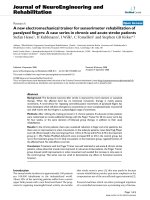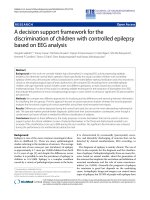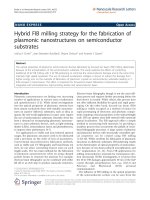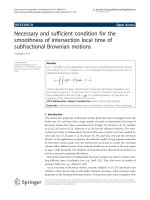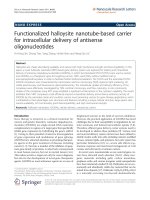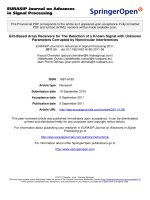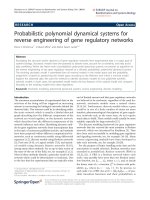Báo cáo hóa học: " Functionalized halloysite nanotube-based carrier for intracellular delivery of antisense oligonucleotides" pdf
Bạn đang xem bản rút gọn của tài liệu. Xem và tải ngay bản đầy đủ của tài liệu tại đây (1.58 MB, 7 trang )
NANO EXPRESS Open Access
Functionalized halloysite nanotube-based carrier
for intracellular delivery of antisense
oligonucleotides
Yin-Feng Shi, Zhong Tian, Yang Zhang, He-Bai Shen and Neng-Qin Jia
*
Abstract
Halloysites are cheap, abundantly available, and natural with high mechanical strength and biocompatibility. In this
paper, a novel halloysite nanotube [HNT]-based gene delivery system was explored for loading and intracellular
delivery of antisense oligodeoxynucleotides [ASODNs], in which functionalized HNTs [f-HNTs] were used as carriers
and ASODNs as a therapeutic gene for targeting survivin. HNTs were firstly surface-modified with g-
aminopropyltriethoxysilane in order to facilitate further biofunctionalization. The f-HNTs and the assembled f-HNT-
ASODN complexes were characterized by transmission electron microscopy [TEM], dynamic light scattering, UV-
visible spectroscopy, and fluorescence spectrophotometry. The intracellular uptake and delivery efficiency of the
complexes were effectively investigated by TEM, confocal microscopy, and flow cytometry. In vitro cytotoxicity
studies of the complexes using MTT assay exhibited a significant enhancement in the cytotoxic capability. The results
exhibited that f-HNT complexes could efficiently improve intracellu lar delivery and enhance antitumor activity of
ASODNs by the nanotube carrier and could be used as novel promising vectors for gene therapy applications, which
is attributed to their advantages over structures and features including a unique tubular structure, large aspect ratio,
natural availability, rich functionality, good biocompatibility, and high mechanical stren gth.
Keywords: halloysite nanotubes, ASODNs, cellular delivery, cytotoxicity, carrier.
Introduction
Gene therapy is attractive as a clinical treatment for
cancers and genetic disorders. Antisense oligodeoxynu-
cleotides [ASODNs] are single-s trand DNA molecules
complementary to regions of a target gene that specifically
inhibit gene expression by hybridizing the gene’smRNA
[1]. Owing to their potential of selective downregulation
of gene expression and modulation of gene splicing,
ASODNs have attracted attention as promising therapeu-
tic agents in the gene treatment of diseases including
cancers [1-3]. Survivin, a member of the inhibitor of apop-
tosis gene family of proteins, is selectively overexpressed
in most human cancers, b ut not in normal t issues [4-6].
This makes survivin a target not only for cancer diagnosis,
but also for the development of novel gene therapeutic
agents. ASODNs as novel anticancer agents are an area of
heightened interest in the field of survivin inhibition.
However, the practical application of ASODNs has faced
challenges due to their susceptibility to degradation by cel-
lular nucleases and limited intracellular uptake [7,8].
Therefore, effi cient gene delivery carrier systems need to
be developed to ad dress these problems [9]. Various viral
and nonviral delivery system carriers have been utilized to
shuttle nucleic acids into cells, including cationic modified
viruses, cationic lipids, and polymers, but each system has
particular limitations [10], i.e., severe side effects (e.g.,
immune response and insertional mutagenesis) of viral
carriers and cell toxicity of cationic carriers.
In recent years, nanomaterials as new nonviral gene car-
riers have attr acted much attention [ 10,11]. Many inor-
ganic materials including gold, carbon nanotubes,
graphene oxide, and various inorganic oxide nanoparticles
have been intensively studied [9-16]. Halloysites are an eco-
nomically and abundantly viable clay material that can be
mined from deposits [17]. Halloysite Al
2
Si
2
O
5
(OH)
4
·nH
2
O
is a naturally occurring two-layered aluminosilicate,
* Correspondence:
The Education Ministry Key Laboratory of Resource Chemistry, Department
of Chemistry, College of Life and Environmental Sciences, Shanghai Normal
University, 100 G uilin Road, Shanghai, 200234, China
Shi et al. Nanoscale Research Letters 2011, 6:608
/>© 2011 Shi et al; licensee Springer. This is an Open Access article distributed under the terms of the Creative Commons Attribution
License ( which permits unrestricted use, distrib ution, and reproduction in any medium,
provided t he original work is properly cited.
chemically similar to kaolin, which has a predominantly
high-aspect-ratio hollow tubular structure in the submic-
rometer range and an internal diameter in the nanometer
range [18]. As for most natural materials, the size of halloy-
site nanotubes [HNTs] generally varies from 50 to 70 nm
in external diameter, a ca. 15 -nm diam eter lum en, and
0.5 to 1 μm in length. The neighboring alumina and silica
layers create a packing disorder causing them to curve and
roll up, forming multilayer tubes. In each HNT, the exter-
nal surface is composed of siloxane (Si-O-Si) groups,
whereas the internal surface consists of a gibbsite-like array
of aluminol (Al-OH) groups. Even though much less stu-
died than carbon nanotubes, due to their interesting struc-
ture and features such as unique tubular structure, large
aspect ratio, cheap and abundant availability, rich function-
ality, good biocompatibility, and high mechanical strength,
HNTs are attractive materials that show great promise in a
rangeofapplicationsasananoscalecontainerforthe
encapsulation of biologically active molecules (e.g., bio-
cides, enzymes, and drugs), as a support for immobilization
of catalyst molecules, controlled drug delivery, bioimplants,
and for protective coating (e.g., anticorrosion or antimold-
ing) [19-23]. Despite these prospects, however, their utiliza-
tion as biocarrier for ASODNs delivery has been less
investigated so far.
In the present work, we de veloped a novel HNT -based
drug delivery system containing ASODNs as a th erapeu-
tic gene for targeting survivin and functionalized HNTs
[f-HNTs] as carriers. Herein, in order to facilitate the
loading and intracellular tracking of ASODNs, f-HNTs
were obtained by surface modification with g-aminopro-
pyltriethoxysilane [APTES], and fluorescein [FAM] was
used to bind to ASODNs as fluorescent labeling. Further-
more, cell ular uptake and deliv ery efficiency of the f-
HNT-ASODN composites as well as cellular apoptosis
induced by the ASODNs transfected with f-HNTs were
investigated through confocal m icroscopy and flow cyto-
metry. The results indicated that these natural, cheap,
and abundantly available clay nanotubes could be used as
novel vectors in the promising application of gene
therapy.
Materials and methods
All reagents used were a vaila ble commerci ally and we re
of high purity grade. The survivin ASODN sequence
used in the current work was 5’ - CCCAGCCTTC-
CAGTCCCTTG and modified with fluorescently labeled
on 5’ end (FAM-CCCAGCCTTCCAGTCCCTTG-3’ ),
which were obtained from Shanghai Sangon B iological
Engineering Technology & Services Co., Ltd. (Shanghai,
China). HNTs were purchased from NaturalNano. Inc.
(Rochester, NY, USA). APTES were obtained from
Sigma-Aldrich (St. Louis, MO, USA).
Synthesis of f-HNT-ASODN complexes
The f-HNT-ASODN complexes wer e prepared as shown
in Figure 1. The f-HNTs were first synthesized according
to the protocols as follows [24]: briefly, 2 mL o f APT ES
was dissolved in 25 mL of dry toluene. Approxima tely
0.6 g of clay powder was add ed, and the suspension was
dispersed ultrasonically for 30 min. The suspension was
then refluxed at 120°C for 20 h under constant stirring. In
the refluxing system, a calcium chloride drying tube was
attached to the end to ensure a dry environment. The
solid phase in the resultant mixture was filtered and
washed six times with fresh toluene to remove the excess
organosilane, then dried overnight at 120°C. Then,
ASODNs, a water soluble cationic gene drug, were bound
to the anionic s urfaces of th e f-HNTs via electro static
interaction. First, 30 μLof20μM ASODN solution and 30
μLof1.25mg/Lf-HNTsweremixedinto1mLwater
solution and stirred for 4 h at room temperature. The
mixture solution was then centrifuged three times at 15,
000 rpm for 10 min. The supernatant was removed, and
the deposition was dispersed in aqueous solution again
with gentle sonication. Thus, free and unbound ASODNs
Figure 1 Schematic view of f-HNT-ASODN-FAM complex preparation.
Shi et al. Nanoscale Research Letters 2011, 6:608
/>Page 2 of 7
in the f- HNT so lution were removed thoroughly by
repeated centrifugation, and the formed f-HNT-ASODN
complexes were then resuspended.
The f-HNTs and f-HNT-ASODN complexes were char-
acterized with transmission electron microscopy [TEM],
dynamic light scattering [DLS] (Malvern Zetasizer
NanoZS90, Malvern Instruments, Ltd., Worcestershire,
UK), UV-visible [UV-Vis] spectrophotometry (Thermo
Multiskan Spectrum, Thermo Scientific, Waltham, MA,
USA), and fluorescence spectrophotometry (Varian Cary-
Eclipse 500, Varian Medical Systems, Palo Alto, CA, USA).
Cellular uptake of the f-HNT-ASODN complexes
Transmission electron microscopy imaging assay
HeLa cells were seeded at a density of 1 × 10
6
cells in a
60-mm tissue culture dish and grown overnight. The cells
were incubated with the f-HNT-ASODN complexes for 6
h, and then the cells were washed thoroughly with chilled
phosphate-buffered saline [PBS], centrifuged into a small
pellet, and fixed with 2% glutaraldehyde in PBS (0.01 M,
pH 7.4) for 120 min, and then washed three times w ith
PBS (10 min every time). The cells were postfixed with 1%
osmium tetroxide in the same buffer for 30 min, then
washed three times with PBS, dehydrated through a series
of alcohol concentrations (30%, 50%, 70%, 90%, 100%),
embedded in Epon, and sliced to a thickness of 70 nm.
Images of the sliced images were recorded at 100 kV using
a Hitachi 600 TEM microscope (Hitachi High-Tech, Min-
ato-ku, Tokyo, Japan).
Confocal microscopy assay
HeLa cells were seeded at 3 × 10
4
cells in a 35-mm Petri
dish and were cultured in b-methox yethoxym ethyl ether
[MEM ] containing 10% fetal bovine serum [FBS] at 37°C
with 5% CO
2
. After cell attachment overnight, the HeLa
cells were treated with f-HNT-ASODN complexes
(1.25 μg/mL), incubated for an additional 4 h in fresh
media, and washed by PBS (pH 7.4) three times before
confocal imaging. The cellular uptake of the f-HNT-
ASODN complexes was examined by confocal laser
microscopy (Carl Zeiss LSM 5 PASCAL, Oberkochen,
Germany). An argon laser for FAM excitati on at 488 nm
was used for imaging, and an oil immersion objective
(Plan Apo, SEIWA OPT ICAL AMERICA INC., Santa
Clara, CA, USA; magnification = 63 × 1.4) was used for
cellular fluorescence imaging.
Flow cytometry analysis
HeLa cells were seeded in six well plates at a density of
2.5 × 10
5
cells/well and incubated i n MEM cell culture
Intensity (%)
Size (d.nm)
Size Distribution by Intensity
Figure 2 TEM images of HNTs (a), f-HNTs (b, c), and f-HNT size distribution measured by DLS (d).
Shi et al. Nanoscale Research Letters 2011, 6:608
/>Page 3 of 7
media for 24 h at 37°C and 5% CO
2
. The cells were then
incubated with f-HNT-ASODN-FAM conjugates in
MEM cell culture media, and after incubation for 4 h at
37°C and 5% CO
2
, the cells were detached using trypsin,
centrifuged at 1, 000 × g for 10 min, and analyzed using a
flowcytometer(SEDiva,BDFACSVantage,Franklin
Lakes, NJ, USA). A total of 1 × 10
5
cells were collected
and analyzed for each sample. Three replicates were
done for each sample. The u ntreated cells were used as
control. The delivery efficiency was calculated as the per-
centage of fluorescent cells out of the total number of
cells. Fluorescence was detected from the FAM labeled
on ASODNs at 488-nm excitation.
In vitro cell toxicity assay of the f-HNT-ASODN complexes
HeLa cells were cultured in a MEM (Gibco, Life Technol-
ogies, Invitrogen Co., Carlsbad, CA, USA) medium supple-
mented with 10% FBS for 12 h at 37°C with 5% CO
2
.For
in vitro cell toxicity assay, cells were seeded into 96 well
plates at a density of 1 × 10
4
cells/plate and treated with
ASODNs (150 nM), f-HNTs (1 .25 μg/mL), and f-HNT-
ASODNs, respectively. After incubation for 24, 48, and
72 h, relative cell viability was measured by standard MTT
assay. In this assay, the cell viability was assessed by moni-
toring the enzymatic reduction of y ellow tetrazolium
MTT (3-(4, 5-dimethylthiazol-2-yl)-2, 5-diphenyl-tetrazo-
lium bromide; Sigma-Aldrich, St. Louis, MO, USA) to a
purple formazan, as measured at 540 nm (Thermo Multis-
kan spectrum, Thermo Scientific, Waltham, MA, USA).
All experiments were done in six copies and illustrated as
average data with error bars.
Results and discussion
The morphologies and structures of HNTs and f-HNTs
were first investigated. It can be seen from the TEM
images (Figure 2a, b) that the HNTs and f-HNTs are hol-
low tubular structures with the outer diameter of approxi-
mately 70 nm, the internal diameter of approximately
15 nm, and the submicrometer range (ca.500nm)in
length, whose size agreed well with the DLS analysis
results(Figure 2d). TEM images of f-HNTs (Figure 2b, c)
showed that there is an apparent thin layer coating on the
surface of the HNTs, indicating the possible surface modi-
fication of APTES. Further more, zet a potential measure-
ments (Table 1) showed that after surface modification of
HNTs, the surface zeta potential value dramatically chan-
ged from -14.3 mV to +44.8 mV. The high-positive surface
charges could be ascribed to the high density of the amine
groups on the APTES f-HNT surface, further verifying
that the negatively charged surface of HNTs was comple-
tely covered with the APTES layer. The as-synt hesized f-
HNTs with abundant amine groups on their surface,
which provide convenient sites for further linking, make
them potentially suitable for the loading and deliv ery of
biomacromolecules.
The binding of ASODNs to f-HNTs was then investi-
gated. Zeta potential measurement, UV-Vis spectra, and
photoluminescence[PL]spectrawereusedtoobserve
the formation of f-HNT-ASODN complexes. After
adsorption of ASODNs, the surface zeta potential of the
f-HNT-based complexes decreased to a less positive
value, suggesting the successful conjugation of DNA
Table 1 Zeta potentials of various samples dispersed in
aqueous solution
Sample Zeta potential (mV)
HNTs -14.3
f-HNTs 44.8
ASODNs -4.92
f-HNT-ASODNs 35.5
Absorbance
Flurorescence Intensity (a.u.)
Wavelen
g
th/nm Wavelen
g
th
(
nm
)
Figure 3 UV-Vis absorbance (a) and fluorescence (b) spectra: f-HNTs (black), naked ASODNs (red), and f-HNT-ASODNs (green).
Shi et al. Nanoscale Research Letters 2011, 6:608
/>Page 4 of 7
(a)
(b)
(c)
Figure 4 TEM and confocal microscopy images and flow cytometry analysis of HeLa cells.(a) TEM photograph of HeLa cells treated with
f-HNT-ASODN-FAM complexes. (b) Confocal laser scanning microscopic images of the f-HNT-ASODN complexes with HeLa cell uptake (FAM
fluorescence was used to label ASODNs; left), bright image (middle), and merged image (right). HeLa cells were taken after a 4-h long incubation
with the f-HNT-ASODN complexes at 37°C, 5% CO
2
, and 95% relative humidity. (c) Flow cytometry of cells incubated with f-HNTs-ASODNs-FAM
(green area) as compared with unlabeled cells (white area), demonstrating that almost each cell has been transfected. After washing, the cells
were analyzed by flow cytometry. Fluorescence was detected from the FAM fluorescent material tagged on ASODNs.
Shi et al. Nanoscale Research Letters 2011, 6:608
/>Page 5 of 7
onto the f-HNT surface. Furthermore, it can be seen
from spectroscopic analysis that the characteristic UV-
Vis absorbance peak for ASODNs at 260 nm superim-
posed on th e characteristic f-HNT absorption spectrum
(Figure 3a). Likewise, fluorescence spectra of f-HNT-
ASODN-FAM and ASODN-FAM showed a similar
fluorescence peak position centering at approximately
520 nm corresponding to the characteristic emission
peak of FAM molecule-conjugated ASODNs (Figure 3b).
These results confirmed that ASODNs had successfully
loaded onto the f-HNTs driven by electrostatic
interaction.
To investigate the intracellular delivery ability of the f-
HNT-ASODN complexes, biological TEM, confocal
microscopy, and flow cytometry were applied t o make
qualitative and quantitative assays of the complexes’ deliv-
ery into the HeLa cells. To visualize intracellular uptake of
the f-HNT-based-ASODN complex, fluorescenc e FAM-
labeled ASODNs were used for the complex formation.
A TEM image of HeLa cells after incubation with t he
complex (Figure 4a) showed that a lot of remarkable black
blots could be seen in the cytoplasm and especially around
the cytoblast, indicating their effect into cells through a
possible endocytosis uptake process. Confocal microscopic
images (Figure 4b) also clearly showed that the f-HNT-
ASODN complexes had entered into the cell cytoplasm
and nucleus from the observation of the FAM fluorescent
signal (green) within cells, which is in accordance with the
obs ervation done using TEM. The results suggested that
the f-HNT-ASODN complexes could effectively transport
into living cells.
Flow cytometry enabled the quantitative assay of deliv-
ery into the cells. HeLa cells incubated with the f-HNT-
ASODN complexes for 4 h were analyzed using flow
cytometry to evaluate the delivery efficiency of the com-
plex and using FAM as fluorescence labeling. Figure 4c
Figure 5 MTT assay of treated HeLa cells. HeLa cells treated with f-HNTs, naked ASODNs, and f-HNT-ASODNs for a period of time including
24, 48, and 72 h. Untreated cells were used as control.
Shi et al. Nanoscale Research Letters 2011, 6:608
/>Page 6 of 7
showed the cellular delivery efficiency of f-HNT-
ASODNs estimated to be 98.69%, indicating that the f-
HNTs had high intracellular delivery ability for
ASODNs. Therefore, f-HNTs could be effective in trans-
porting DNA inside the cells and could be utilized as
efficient gene delivery vectors, which were mostly attrib-
uted that the stable f-HNT complex with high loading
capacity could prevent DNA from enzyme degradation
In order to examine cellular apoptosis induced by the
ASODNs tran sfected by f-HNTs, MTT assay was per-
formed to evaluate their cytotoxicity effect on tumor cells.
The HeLa cells were incubated with the f-HNT-ASODN
complexes, free ASODNS, and f-HNTs for 24, 48, and 72
h, respectively. As shown in Figu re 5, f -HNT-ASODN
complexes displayed a significant enhancement in the
cytotoxic capability compared with that of the ASODNs
alone. Furthermore, the cells treated with f-HNT-
ASODNs showed an increased cell apoptosis with time
elongation. It was also observed that there is a minimum
level of cell apoptosis upon treatment with f-HNTs, indi-
cating that the functionalized nanotubes themselves hav e
low cytotoxicity. Therefore, the f-HNTs could be used as a
suitable carrier for therapeutic gene delivery applications
due to its high surface area, efficient intracellular trans-
porting ability, and good biocompatibility.
Conclusions
In summa ry, we have prepared a novel gene delivery sys-
tem with f-HNTs as carrier for loading and intracellular
delivering of ASODNs. The obtained results exhibited that
f-HNT-ASODN complexes could efficiently improve
intracellular delivery and enhance antitumor activity of
ASODNs transfected by the nanotube carrier. Therefo re,
with the benef its of having a unique tubular structure,
large aspect ratio , abundant availability, good biocompat-
ibility, and high mechanical strength, the HNTs could
hold a great promise as a viable and inexpensive nanocar-
rier for biological delivery applications and gene therapy.
Acknowledgements
This work was supported by the program for New Century Excellent Talents
in University (NCET-08-0897), Shanghai Education Committee (09SG43,
S30406), National 973 Project (2010CB933901), and Shanghai Key Laboratory
of Rare Earth Functional Materials, Shanghai Normal University (DZL806).
Authors’ contributions
YFS carried out the biological studies. ZT helped synthesize the material. YZ
gave some help in experimental characterization. YFS drafted the
manuscript. NQJ and HBS conceived the study. NQJ participated in its
design and coordination and helped draft and revise the manuscript.
Competing interests
The authors declare that they have no competing interests.
Received: 23 September 2011 Accepted: 28 November 2011
Published: 28 November 2011
References
1. Stahel RA, Zangemeister-Wittke U: Antisense oligonucleotides for cancer
therapy-an overview. Lung Cancer 2003, 41:S81-S88.
2. Biroccio A, Leonetti C, Zupi G: The future of antisense therapy:
combination with anticancer treatments. Oncogene 2003, 22:6579-6587.
3. White LK, Wright WE, Shay J: Telomerase inhibitors. Trends Biotechnol 2001,
19:114-120.
4. Sun C, Nettesheim D, Liu Z, Olejniczak ET: Solution structure of human survivin
and its binding interface with Smac/Diablo. Biochemistry 2005, 11-17.
5. Altieri DC: Survivin, versatile modulation of cell division and apoptosis in
cancer. Oncogene 2003, 22:8581-8589.
6. Altieri DC: Validating survivin as a cancer therapeutic target. Nat Rev
Cancer 2003, 3:46-54.
7. Rosi NL, Giljohann DA, Thaxton CS, Lytton-Jean AKR, Han MS, Mirkin CA:
Oligonucleotide-modified gold nanoparticles for intracellular gene
regulation. Science 2006, 312:1027-1030.
8. Mier W, Eritja R, Mohammed A, Haberkorn U, Eisenhut M: Preparation and
evaluation of tumor-targeting peptide-oligonucleotide conjugates.
Bioconjug Chem 2000, 11:855-860.
9. Jia NQ, Lian Q, Shen HB, Wang C, Li X, Yang Z: Intracellular delivery of
quantum dots tagged antisense oligodeoxynucleotides by functionalized
multiwalled carbon nanotubes. Nano Lett 2007, 7:2976-2980.
10. Xu ZP, Zeng QH, Lu GQ, Yu AB: Inorganic nanoparticles as carriers for
efficient cellular delivery. Chem Eng Sci 2006, 61:1027-1040.
11. Sun XM, Zhang Y, Shen HB, Jia NQ: Direct electrochemistry and
electrocatalysis of horseradish peroxidase based on halloysite nanotubes/
chitosan nanocomposite film. Electrochim Acta 2010, 50:700-705.
12. Wang F, Wang Y-C, Dou S, Xiong M-H, Sun T-M, Wang J: Doxorubicin-
tethered responsive gold nanoparticles facilitate intracellular drug
delivery for overcoming multidrug resistance in cancer cells. ACS Nano
2011, 5:3679-3692.
13. Kim J-H, Jang HH, Ryou S-M, Kim S, Bae J, Lee K, Han MS: A functionalized
gold nanoparticles-assisted universal carrier for antisense DNA. Chem
Comm 2010, 46:4151-4153.
14. Wang Y, Li Z, Hu D, Lin C-T, Li J, Lin Y: Aptamer/graphene oxide
nanocomplex for in situ molecular probing in living cells. J Am Chem Soc
2010, 132:9274-9276.
15. Robinson JT, Tabakman SM, Liang Y, Wang H, Casalongue HS, Vinh D,
Dai H: Ultrasmall reduced graphene oxide with high near-infrared
absorbance for photothermal therapy. J Am Chem Soc 2011,
133:6825-6831.
16. Sun X, Liu Z, Welsher K, Robinson JT, Goodwin A, Zaric S, Dai H: Nano-
graphene oxide for cellular imaging and drug delivery. Nano Res 2008,
1:203-212.
17. Lvov YM, Shchukin DG, Mohwald H, Price RR: Halloysite clay nanotubes for
controlled release of protective agents. ACS Nano 2008, 2:814-820.
18. Guimaraes L, Enyashin AN, Seifert G, Duarte HA: Structural, electronic, and
mechanical properties of single-walled halloysite nanotube models.
J Phys Chem C 2010, 114:11358-11363.
19. Vergaro V, Abdullayev E, Lvov YM, Zeitoun A, Cingolani R, Rinaldi R,
Leporatti S: Cytocompatibility and uptake of halloysite clay nanotubes.
Biomacromolecules 2010, 11:820-826.
20. Joussein E, Petit S, Theng B, Righi D, Delvaux B: Halloysite clay minerals–a
review. Clay Minerals 2005, 40:383-426.
21. Tari G, Bobos I, Gomes CSF, Ferreira JMF: Modification of surface charge
properties during kaolinite to halloysite-7Å transformation. J Colloid and
Interface Sci 1999, 210:360-366.
22. Price RR, Gaber BP, Lvov Y: In-vitro release characteristics of tetracycline
HCl, khellin and nicotinamide adenine dineculeotide from halloysite: a
cylindrical mineral. J Microencapsulation 2001, 18:713-722.
23. Abdullayev E, Price R, Shchukin D, Lvov Y: Halloysite tubes as
nanocontainers for anticorrosion coating with benzotriazole. Appl Mater
Interfaces 2009, 1:1437-1443.
24. Yuan P, Southon PD, Liu Z, Green MER, Hook JM, Antill SJ, Kepert CJ:
Functionalization of halloysite clay nanotubes by grafting with γ-
aminopropyltriethoxysilane. J Phys Chem C 2008, 112:15742-15751.
doi:10.1186/1556-276X-6-608
Cite this article as: Shi et al.: Functionalized halloysite nanotube-based
carrier for intracellular delivery of antisense oligonucleotides. Nanoscale
Research Letters 2011 6:608.
Shi et al. Nanoscale Research Letters 2011, 6:608
/>Page 7 of 7

